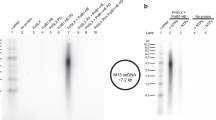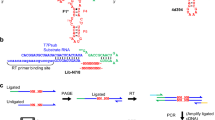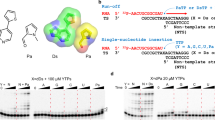Abstract
DNAzymes have become attractive due to their potential biomedical and biotechnological applications, as well as their advantages in terms of stability, efficiency and synthetic accessibility with respect to protein or RNA catalysts. However, a lack of knowledge about the catalytic mechanisms of DNAzymes hampers further developments. Here, by means of high-level quantum mechanics/molecular mechanics simulations and biochemical studies, we determine the mechanism of RNA ligation catalysed by the 9DB1 DNAzyme. Our findings show that the mechanism consists of a single concerted asynchronous transition state where the O3′ atom of the acceptor RNA first attacks the α-phosphate group of the donor nucleotide, whereas the leftover proton from the O3′ atom is then transferred to the DNA. The mechanism involves the active participation of two Mg2+ ions, not present in the crystal structure but for which clear binding sites can be located.
This is a preview of subscription content, access via your institution
Access options
Access Nature and 54 other Nature Portfolio journals
Get Nature+, our best-value online-access subscription
$29.99 / 30 days
cancel any time
Subscribe to this journal
Receive 12 digital issues and online access to articles
$119.00 per year
only $9.92 per issue
Buy this article
- Purchase on Springer Link
- Instant access to full article PDF
Prices may be subject to local taxes which are calculated during checkout






Similar content being viewed by others
Data availability
The data that support the plots within this paper and other findings of this study are available from the corresponding author on reasonable request.
References
Kruger, K. et al. Self-splicing RNA: autoexcision and autocyclization of the ribosomal RNA intervening sequence of tetrahymena. Cell 31, 147–157 (1982).
Guerrier-Takada, C. et al. The RNA moiety of ribonuclease P is the catalytic subunit of the enzyme. Cell 35, 849–857 (1983).
Guerrier-Takada, C. & Altman, S. Catalytic activity of an RNA molecule prepared by transcription in vitro. Science 223, 285–286 (1984).
Ward, W. L., Plakos, K. & DeRose, V. J. Nucleic acid catalysis: metals, nucleobases, and other cofactors. Chem. Rev. 114, 4318–4342 (2014).
Fedor, M. J. & Williamson, J. R. The catalytic diversity of RNAs. Nat. Rev. Mol. Cell Biol. 6, 399–412 (2005).
Bertran, J. & Oliva, A. in Simulating Enzyme Reactivity: Computational Methods in Enzyme Catalysis (eds Tuñón, I. & Moliner, V.) 404–435 (The Royal Society of Chemistry, 2017).
Tollefsbol, T. (ed.) Handbook of Epigenetics: The New Molecular and Medical Genetics (Academic Press, Cambridge, 2011).
Berger, S. L. The complex language of chromatin regulation during transcription. Nature 447, 407–412 (2007).
Breaker, R. R. & Joyce, G. F. A DNA enzyme that cleaves RNA. Chem. Biol. 1, 223–229 (1994).
Silverman, S. K. Catalytic DNA (deoxyribozymes) for synthetic applications-current abilities and future prospects. Chem. Commun. 0, 3467–3485 (2008).
Silverman, S. K. Catalytic DNA: scope, applications, and biochemistry of deoxyribozymes. Trends Biochem. Sci. 41, 595–609 (2016).
Silverman, S. K. DNA as a versatile chemical component for catalysis, encoding, and stereocontrol. Angew. Chem. Int. Ed. 49, 7180–7201 (2010).
Purtha, W. E., Coppins, R. L., Smalley, M. K. & Silverman, S. K. General deoxyribozyme-catalyzed synthesis of native 3′-5′ RNA linkages. J. Am. Chem. Soc. 127, 13124–13125 (2005).
Flynn-Charlebois, A. et al. Deoxyribozymes with 2′-5′ RNA ligase activity. J. Am. Chem. Soc. 125, 2444–2454 (2003).
Cuenoud, B. & Szostak, J. W. A. DNA metalloenzyme with DNA ligase activity. Nature 375, 611–614 (1995).
Carmi, N., Balkhi, S. R. & Breaker, R. R. Cleaving DNA with DNA. Proc. Natl Acad. Sci. USA 95, 2233–2237 (1998).
Wang, M. et al. In vitro selection of DNA-cleaving deoxyribozyme with site-specific thymidine excision activity. Nucleic Acids Res. 42, 9262–9269 (2014).
Chandra, M., Sachdeva, A. & Silverman, S. K. DNA-catalyzed sequence-specific hydrolysis of DNA. Nat. Chem. Biol. 5, 718–720 (2009).
Parker, D. J., Xiao, Y., Aguilar, J. M. & Silverman, S. K. DNA catalysis of a normally disfavored RNA hydrolysis reaction. J. Am. Chem. Soc. 135, 8472–8475 (2013).
Wang, W., Billen, L. P. & Li, Y. Sequence diversity, metal specificity, and catalytic proficiency of metal-dependent phosphorylating DNA enzymes. Chem. Biol. 9, 507–517 (2002).
Li, Y., Liu, Y. & Breaker, R. R. Capping DNA with DNA. Biochemistry 39, 3106–3114 (2000).
Chinnapen, D. J.-F. & Sen, D. A deoxyribozyme that harnesses light to repair thymine dimers in DNA. Proc. Natl Acad. Sci. USA 101, 65–69 (2004).
Li, Y. & Sen, D. A catalytic DNA for porphyrin metallation. Nat. Struct. Biol. 3, 743–747 (1996).
Silverman, S. K. Pursuing DNA catalysts for protein modification. Acc. Chem. Res. 48, 1369–1379 (2015).
Pradeepkumar, P. I., Höbartner, C., Baum, D. A. & Silverman, S. K. DNA-catalyzed formation of nucleopeptide linkages. Angew. Chem. Int. Ed. 47, 1753–1757 (2008).
Xiang, Y. & Lu, Y. DNA as sensors and imaging agents for metal ions. Inorg. Chem. 53, 1925–1942 (2014).
Shen, Z. et al. A catalytic DNA activated by a specific strain of bacterial pathogen. Angew. Chem. Int. Ed. 55, 2431–2434 (2016).
Baum, D. A. & Silverman, S. K. Deoxyribozyme-catalyzed labeling of RNA. Angew. Chem. Int. Ed. 46, 3502–3504 (2007).
Orbach, R., Willner, B. & Willner, I. Catalytic nucleic acids (DNAzymes) as functional units for logic gates and computing circuits: from basic principles to practical applications. Chem. Commun. 51, 4144–4160 (2015).
Cai, H. et al. DNAzyme targeting c-jun suppresses skin cancer growth. Sci. Transl. Med. 4, 139ra82 (2012).
Crunkhorn, S. Asthma: DNAzyme attenuates allergic asthma. Nat. Rev. Drug Discov. 14, 460–460 (2015).
Ponce-Salvatierra, A., Wawrzyniak-Turek, K., Steuerwald, U., Höbartner, C. & Pena, V. Crystal structure of a DNA catalyst. Nature 529, 231–234 (2016).
Behera, A. K. et al. Enhanced deoxyribozyme-catalyzed RNA ligation in the presence of organic cosolvents. Biopolymers 99, 382–391 (2013).
Büttner, L., Seikowski, J., Wawrzyniak, K., Ochmann, A. & Höbartner, C. Synthesis of spin-labeled riboswitch RNAs using convertible nucleosides and DNA-catalyzed RNA ligation. Bioorg. Med. Chem. 21, 6171–6180 (2013).
Barducci, A., Bussi, G. & Parrinello, M. Well-tempered metadynamics: a smoothly converging and tunable free-energy method. Phys. Rev. Lett. 100, 020603 (2008).
Genna, V. et al. Self-activated mechanism for nucleic acid polymerization catalyzed by DNA/RNA polymerases. J. Am. Chem. Soc. 138, 14592–14598 (2016).
Wu, S., Jiang, M. & Liu, L. Mechanism of pyrophosphate ion release in T7 RNA polymerase revealed by free energy simulations. Comput. Theor. Chem. 1094, 127–132 (2016).
Da, L. T., Wang, D. & Huang, X. Dynamics of pyrophosphate ion release and its coupled trigger loop motion from closed to open state in RNA polymerase II. J. Am. Chem. Soc. 134, 2399–2406 (2012).
Forconi, M. & Herschlag, D. (ed.) in Biophysical, Chemical, and Functional Probes of RNA Structure, Interactions and Folding: Part A Vol. 468, 311–333 (Academic Press, 2009).
Loverix, S., Winqvist, A., Strömberg, R. & Steyaert, J. Mechanism of RNase T1: concerted triester-like phosphoryl transfer via a catalytic three-centered hydrogen bond. Chem. Biol. 7, 651–658 (2000).
Steltz, T. A. A mechanism for all polymerases. Nature 391, 231–232 (1998).
Shechner, D. M. & Bartel, D. P. The structural basis of RNA-catalyzed RNA polymerization. Nat. Struct. Mol. Biol. 18, 1036–1042 (2011).
Zhao, C. & Pyle, A. M. Structural insights into the mechanism of group II intron splicing. Trends Biochem. Sci. 42, 470–482 (2017).
Galej, W. P., Toor, N., Newman, A. J. & Nagai, K. Molecular mechanism and evolution of nuclear pre-mRNA and group II intron splicing: insights from cryo-electron microscopy structures. Chem. Rev. 118, 4156–4176 (2018).
Stahley, M. R. & Strobel, S. A. Structural evidence for a two-metal-ion mechanism of group I intron splicing. Science 309, 1587–1590 (2005).
Berdis, A. J. Mechanisms of DNA polymerases. Chem. Rev. 109, 2862–2879 (2009).
Mattioli, E. J., Bottoni, A. & Calvaresi, M. DNAzymes at work: a DFT computational investigation on the mechanism of 9DB1. J. Chem. Inf. Model. 59, 1547–1553 (2019).
Wachowius, F. & Höbartner, C. Probing essential nucleobase functional groups in aptamers and deoxyribozymes by nucleotide analogue interference mapping of DNA. J. Am. Chem. Soc. 133, 14888–14891 (2011).
Gelpí, J. L. et al. Classical molecular interaction potentials: improved setup procedure in molecular dynamics simulations of proteins. Proteins Struct. Funct. Genet. 45, 428–437 (2001).
Orozco, M. & Luque, F. J. Theoretical methods for the description of the solvent effect in biomolecular systems. Chem. Rev. 100, 4187–4226 (2000).
Case, D. A. et al. AMBER 14 (University of California, San Francisco, 2014).
Jorgensen, W. L., Chandrasekhar, J., Madura, J. D., Impey, R. W. & Klein, M. L. Comparison of simple potential functions for simulating liquid water. J. Chem. Phys. 79, 926–935 (1983).
Allnér, O., Nilsson, L. & Villa, A. Magnesium ion-water coordination and exchange in biomolecular simulations. J. Chem. Theory Comput. 8, 1493–1502 (2012).
Meagher, K. L., Redman, L. T. & Carlson, H. A. Development of polyphosphate parameters for use with the AMBER force field. J. Comput. Chem. 24, 1016–1025 (2003).
Ivani, I. et al. Parmbsc1: a refined force field for DNA simulations. Nat. Methods 13, 55–58 (2015).
Cheatham, T. E., Cieplak, P. & Kollman, P. A. A modified version of the Cornell et al. force field with improved sugar pucker phases and helical repeat. J. Biomol. Struct. Dyn. 16, 845–862 (1999).
Wang, J., Cieplak, P. & Kollman, P. A. How well does a restrained electrostatic potential (RESP) model perform in calculating conformational energies of organic and biological molecules? J. Comput. Chem. 21, 1049–1074 (2000).
Pérez, A. et al. Refinement of the AMBER force field for nucleic acids: improving the description of α/γ conformers. Biophys. J. 92, 3817–3829 (2007).
Zgarbová, M. et al. Refinement of the Cornell et al. nucleic acids force field based on reference quantum chemical calculations of glycosidic torsion profiles. J. Chem. Theory Comput. 7, 2886–2902 (2011).
Mlýnský, V. et al. Comparison of ab Initio, DFT, and semiempirical QM/MM approaches for description of catalytic mechanism of hairpin ribozyme. J. Chem. Theory Comput. 10, 1608–1622 (2014).
Torrie, G. M. & Valleau, J. P. Nonphysical sampling distributions in Monte Carlo free-energy estimation: umbrella sampling. J. Comput. Phys. 23, 187–199 (1977).
Kumar, S., Rosenberg, J. M., Bouzida, D., Swendsen, R. H. & Kollman, P. A. Multidimensional free‐energy calculations using the weighted histogram analysis method. J. Comput. Chem. 16, 1339–1350 (1995).
Ufimtsev, I. S. & Martinez, T. J. Quantum chemistry on graphical processing units. 3. Analytical energy gradients, geometry optimization, and first principles molecular dynamics. J. Chem. Theory Comput. 5, 2619–2628 (2009).
Götz, A. W., Clark, M. A. & Walker, R. C. An extensible interface for QM/MM molecular dynamics simulations with AMBER. J. Comput. Chem. 35, 95–108 (2014).
Schowen, K. B. & Schowen, R. L. Solvent isotope effects of enzyme systems. Methods Enzymol. 87, 551–606 (1982).
Acknowledgements
This work has been supported by the Spanish Ministry of Science (BFU2014-61670-EXP); the Catalan SGR; the Instituto Nacional de Bioinformática; the European Research Council (SimDNA); the European Union’s Horizon 2020 research and innovation program under grant agreement no. 676556; the Biomolecular and Bioinformatics Resources Platform (ISCIII PT 13/0001/0030), co-funded by the Fondo Europeo de Desarrollo Regional and the MINECO Severo Ochoa Award of Excellence (Government of Spain; awarded to IRB Barcelona). M.O. is an ICREA academia researcher. J.A. acknowledges the Spanish Ministry of Science for a Juan de la Cierva postdoctoral grant. H.G. acknowledges the Spanish Ministry of Science for a Juan de la Cierva postdoctoral grant. M.T. acknowledges the Instituto de Salud Carlos III for a Miguel Servet grant. We thank F. Eckstein, I. Brun-Heath, A. Grandas, E. Pedroso and R. Eritja for their help and valuable comments. We are indebted to J. L. Gelpí for his help in the processing of kinetic data.
Author information
Authors and Affiliations
Contributions
J.A. performed the simulations, analysed the data and discussed the experiments. M.T. performed the experiments, analysed the data and discussed the simulations. H.G. contributed in the simulations. N.V. contributed to all of the experiments and M.O. directed and supervised the research. J.A., M.T. and M.O. wrote the manuscript with input from all authors.
Corresponding author
Ethics declarations
Competing interests
The authors declare no competing interests.
Additional information
Publisher’s note: Springer Nature remains neutral with regard to jurisdictional claims in published maps and institutional affiliations.
Supplementary information
Supplementary Information
Supplementary methods, Supplementary Figs. 1–17, Supplementary Tables 1 and 2, Supplementary references.
Supplementary Data 1
Products FES QM/MM
Supplementary Data 2
Reactants FES QM/MM
Supplementary Data 3
Transition State FES QM/MM
Supplementary Data 4
Final Structure MD
Supplementary Data 5
Initial Structure MD
Supplementary Data 6
Final Structure MD Post Catalytic
Supplementary Data 7
Initial Structure MD Post Catalytic
Supplementary Data 8
Final Structure MD Pre Catalytic
Supplementary Data 9
Initial Structure MD Pre Catalytic
Supplementary Data 10
Products PES QM/MM B3lyp
Supplementary Data 11
Reactants PES QM/MM B3lyp
Supplementary Data 12
Transition State PES QM/MM B3lyp
Supplementary Data 13
Products PES QM/MM Blyp
Supplementary Data 14
Reactants PES QM/MM Blyp
Supplementary Data 15
Transition State PES QM/MM Blyp
Supplementary Data 16
Intermediate1 QM/MM PPI deprotonation
Supplementary Data 17
Products2 QM/MM PPI deprotonation
Supplementary Data 18
Reactants1 QM/MM PPI deprotonation
Supplementary Data 19
Reactants2 QM/MM PPI deprotonation
Supplementary Data 20
Transition State1 QM/MM PPI deprotonation
Supplementary Data 21
Transition State2 QM/MM PPI deprotonation
Supplementary Video 1
Reaction Mechanism
Supplementary Video 2
Reactant
Supplementary Video 3
Transition State
Supplementary Video 4
Products
Rights and permissions
About this article
Cite this article
Aranda, J., Terrazas, M., Gómez, H. et al. An artificial DNAzyme RNA ligase shows a reaction mechanism resembling that of cellular polymerases. Nat Catal 2, 544–552 (2019). https://doi.org/10.1038/s41929-019-0290-y
Received:
Accepted:
Published:
Issue Date:
DOI: https://doi.org/10.1038/s41929-019-0290-y
This article is cited by
-
How DNA catalyses RNA ligation
Nature Catalysis (2019)



